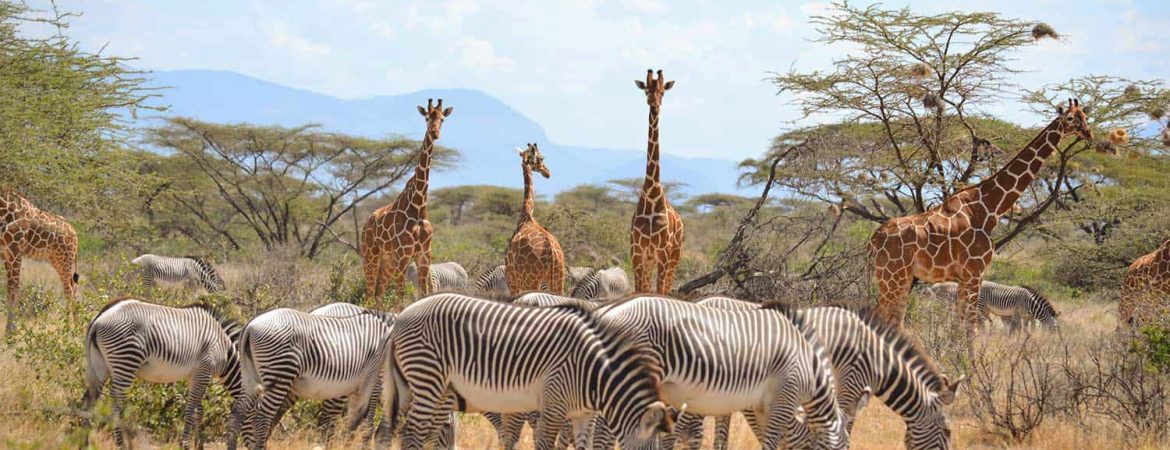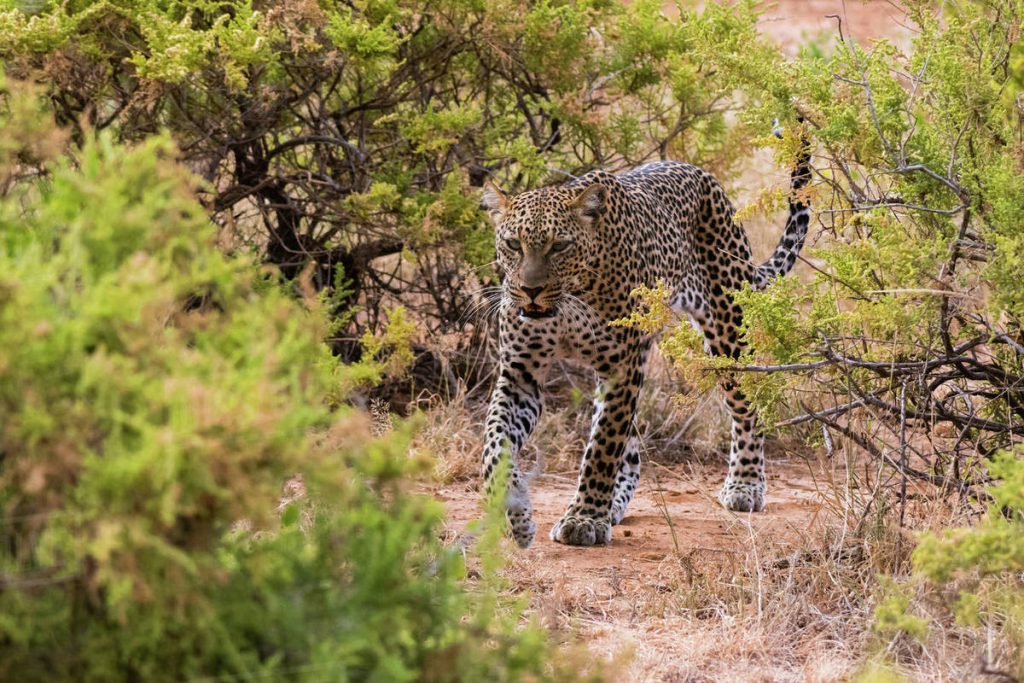Samburu National Reserve
Samburu National Reserve is one of the smallest national parks in Kenya located in the southeastern corner Samburu district in the rift valley province of Kenya, Samburu national park is a rich ecological system covering an area of 165 square kilometers. The wealth wildlife home borders Ewaso Nyiro River (meaning brown water) which borders separate it from buffalo springs national reserve. Samburu national park at an altitude of range between 800 to 1230 meters above the sea level lies in Samburu county, river Ewaso Ng’iro flows in the middle of the park through doum palm groves and thick riverine forest creating a beautiful scenic view and the river acts as a source of water to the animals for their survival on arid region the park is situated. Samburu national reserve established in 1985 is 345 kilometers from Nairobi the capital city of Kenya.

Samburu national park the beauty of the dry northern region of Kenya is famous for being a place where magical lioness kamunyak who adopted a baby Oryx lived, the reserve is also one of the two places in which conservationist and a game warden George Adamson and his wife Joy Adamson the raised Elsa the lioness (the first female lion raised with her sisters Big One and Lustica. The life of Elsa the lioness was told in a book named born free which gained her fame after winning multiple awards.
Samburu national reserve is an aromatic spot full of breathtaking sceneries from savannah plains, rugged regions and many vegetation types including acacia, thorn trees, riverine forests, and grassland vegetation, while you just entered the reserve you are presented a magical view of two mountains visible of Koitogor and Ololokwe. Samburu national park the most peaceful park filled with natural serenity can be accessed using ngeye mare and buffalo springs gates is the entrance gates to the park, the park a perfect destination for Kenya wildlife safaris as it is a home a number of wildlife species, for example, the big three cats (lion, cheetah and African leopard), herds of elephants, cape buffalo and hippopotamus. Mammals in the park include olive baboon, warthogs, Grant’s gazelle, Kirk’s dik-dik, impala, and waterbuck, the park used to harbor rhinoceros but due to heavy poaching, they are no longer available in the reserve.
Samburu national park is a haven for many bird species approximately 350 species good for bird viewing, the birds include grey-headed kingfisher, sunbirds, bee-eaters, Marabou stork, tawny eagle, Verreaux’s eagle, Bateleur, vulturine Guinea fowl, yellow-necked spurfowl, lilac-breasted roller, secretary bird, superb starling, northern red-billed hornbill, yellow-billed hornbill and vultures including the palm-nut vulture. The park also hosts rare northern special species commonly known as Samburu special five that is Gravy’s zebra, Somali ostrich, reticulated giraffe, gerenuk, and beisa Oryx.
Samburu national park is surrounded Communities of Rendille, Borana and the dominant Samburu tribe, a descendant clan of the Masai living around the park, the culture and norms of these communities offer
Attractions of interest in Samburu national park
- River Ewaso Nyiro. River Ewaso Nyiro is Kenya’s biggest river and the largest water source in Samburu national; reserve supporting the lives of the animals, the river supports magnificent riverine forest as it flows north to east meandering off to south east through Somalia to join river Jubba. River Ewaso Nyiro is home to large numbers of Nile crocodiles and many animals are spotted as they visit the river to drink water.
- Samburu special five. Samburu national reserve is a beauty offering one of a kind and extra amazing game drives as it hosts rare unique animals that are rarely seen in Africa. These animals which are seen during game drives and nature walks are grey zebra, Somali ostrich, reticulated giraffe, gerenuk, and the beisa Oryx. These animals are seen grazing in savanna grassland filled park and riverine forests.
- Riverine forest. Riverine forests in Samburu national reserve are attractive on its own, being extremely green with a cool breeze. In these forests many bird species can be seen hanging and playing on the tree of trees, many beautiful colored birds are such as grey-headed kingfisher, sunbirds, bee-eaters, Marabou stork, tawny eagle, Verreaux’s eagle, Bateleur, vulturine Guinea fowl, yellow-necked spurfowl are spotted
- Mount Koitogor and mount Ololokwe. These mounts are seen soon as you enter the park, they add on the beauty of the national reserve. Many small animals are seen resting on these mounts in the of the middle of the reserve
- Samburu culture. Samburu national reserve is home many tribes with Samburu tribe being dominant, this tribe’s culture, norms, and practices have attracted tourists interested in cultural tours. The Samburu people are so attached to their animals that goats, camels, and cattle, the Samburu people are fond of painting their faces with striking patterns so as to accentuate their facial features. This action is admired by neighboring tribes hence Samburu meaning butterfly.
- Camelback rides. Riding a camel into the wilderness of Samburu national reserve is one breathtaking and amazing experience, this is a traditional way of touring the reserve which allows get up close to the animals in the park.
- Big three cats. Samburu national reserve is home to the three big cats that is lions, leopards, and cheetahs which are of interest too numerous tourists attracting a large number of tourists to this park. These animals are spotted drinking water in river Ewaso Nyiro and grazing in the wilderness.

Activities in Samburu National Reserve
- Game drives. There is nothing more captivating on a safari than a game drive in Samburu national reserve, the game drives take the tourist through the rugged semi-arid plains of the park while enjoying the beautiful view of the river surrounded by forests. On game drives, you get to see different animals such as lions, leopards, cheetahs, herds of elephants, gravy’s zebras and numerous birds are also spotted a kingfisher, sunbirds, bee-eaters, Marabou stork, tawny eagle, Verreaux’s eagle, Bateleur, vulturine Guinea fowl, yellow-necked spurfowl, a lilac-breasted roller.
- Camelback safaris. Camelback safaris in Samburu national park are one amazing unique traditional way of touring the wilderness, camelback riding gives an opportunity to enjoy the open environment in the park filled with beautiful scenery and numerous animals. While on camelback riding tourist are able to get up close to the animals.
- Bush breakfast. Samburu national reserve offers an extraordinary breakfast in the bush of the park while enjoying food tourists get a chance to experience how it feels to be in the wilderness while getting sights of wildlife moving freely in the park.
- Mount biking. Mountain biking is another thrilling activity in Samburu national park which involves using bikes to tour the wilderness. In this semi-arid plain in the park while enjoying the intoxicating views of the vegetation, animals, birds and the river streaming through the forest.
Other activities offered in Samburu national reserve include Guided walks, culture tours, bird watching, and big cats tracking
Months of December-march and late March to May are the best time to visit Samburu national reserve, these months are less hot as the park receives a little rainfall. The park receives two rain seasons from late March until May and again in November.
Samburu national reserve can be reached using either by road or by air, there is daily scheduled flights from Nairobi to Samburu airstrip. Road drive is a 5 hours and 40 minutes’ drive of approximately 300 square kilometers from Nairobi.
While touring in Samburu national reserve accommodation can be got from Samburu Intrepids Tented Camp, elephant bedroom camp, Samburu Sopa lodge, elephant watch camp, Sabache Camp and many more.


